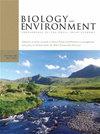Using High Frequency In-Situ Monitoring to Gain New Insights into Irish Aquatic Systems
IF 0.6
4区 环境科学与生态学
Q4 ENVIRONMENTAL SCIENCES
Biology and Environment-Proceedings of the Royal Irish Academy
Pub Date : 2022-12-21
DOI:10.1353/bae.2022.0014
引用次数: 0
Abstract
ABSTRACT:Until recent decades, most monitoring of surface waters relied exclusively on samples analysed in the laboratory for ecologically and management-relevant parameters. It is now possible, however, to automatically monitor many parameters using in-situ sensors and to provide remote web-based access to these data. Such data are typically provided at frequencies of minutes rather than at the weekly, fortnightly or monthly intervals typical of traditional monitoring and therefore capture both short-term change and, for inter-annual deployments, long-term trends. Here we give an overview of the use of high frequency monitoring (HFM) in Ireland and present case studies from a set of four sites, representative of the catchment-stream-lake-estuary continuum, to illustrate new insights that such deployments can provide. These include effects of cattle access on stream turbidity; biogeochemical processing in agricultural streams; effects of summer storms on dissolved organic matter in a catchment and lake; and changes in a trophic index in an estuarine setting. We discuss the additional information provided by such systems when compared to traditional monitoring, some of the challenges related to their use, and assess the future use of HFM to inform management of and policy for aquatic systems on the island of Ireland.使用高频原位监测获得爱尔兰水生系统的新见解
摘要:直到最近几十年,大多数地表水监测完全依赖于实验室分析的生态和管理相关参数样本。然而,现在有可能使用原位传感器自动监测许多参数,并提供对这些数据的远程网络访问。这种数据通常以分钟为单位提供,而不是传统监测通常以每周、每两周或每月为间隔提供,因此既能捕捉短期变化,又能捕捉年际部署的长期趋势。在这里,我们概述了高频监测(HFM)在爱尔兰的使用情况,并介绍了来自四个地点的案例研究,这些地点代表了集水区-溪流-湖泊-河口连续体,以说明这种部署可以提供的新见解。这些因素包括牛群进入对河流浊度的影响;农业溪流生物地球化学处理;夏季暴雨对流域湖泊溶解有机质的影响以及河口环境中营养指数的变化。我们讨论了与传统监测相比,这些系统提供的额外信息,与它们的使用相关的一些挑战,并评估了HFM在爱尔兰岛水生系统管理和政策方面的未来使用。
本文章由计算机程序翻译,如有差异,请以英文原文为准。
求助全文
约1分钟内获得全文
求助全文
来源期刊
CiteScore
1.10
自引率
0.00%
发文量
6
审稿时长
>36 weeks
期刊介绍:
The journal aims to offer a broad coverage of the subject area, including the following:
- biology and ecology of the Irish flora and fauna
- microbial ecology
- animal, plant and environmental physiology
- global change
- palaeoecology and palaeoclimatology
- population biology; conservation of genetic resources
- pollution and environmental quality; ecotoxicology
- environmental management
- hydrology
- land use, agriculture, soils and environment.
Submissions on other relevant topics are also welcome, and papers of a cross-disciplinary nature are particularly encouraged.

 求助内容:
求助内容: 应助结果提醒方式:
应助结果提醒方式:


